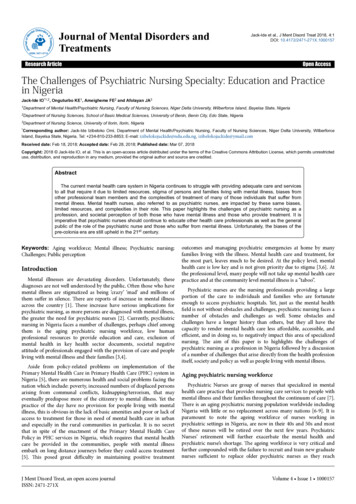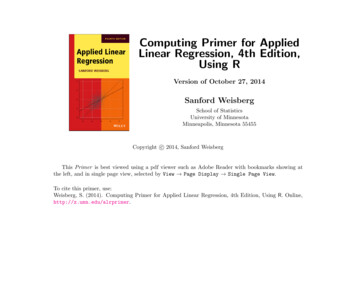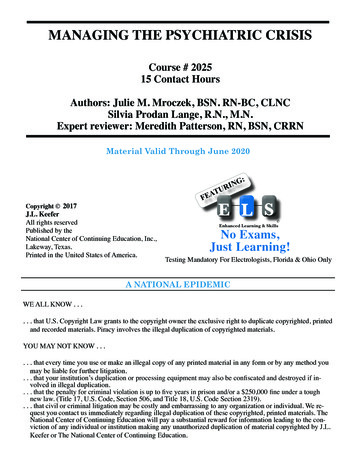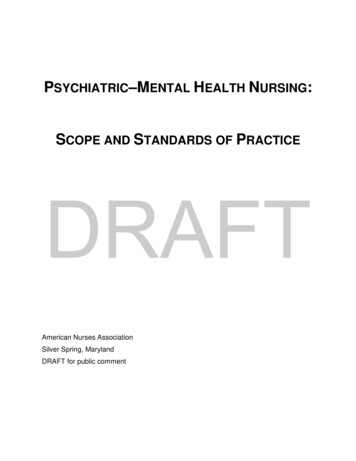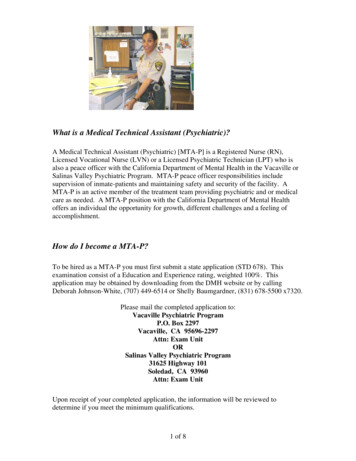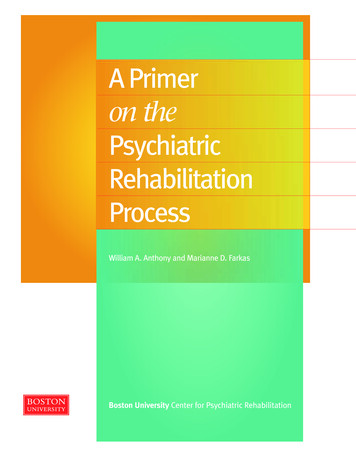
Transcription
A Primeron thePsychiatricRehabilitationProcessWilliam A. Anthony and Marianne D. FarkasBoston University Center for Psychiatric Rehabilitation
2009, Center for Psychiatric Rehabilitation, Trustees of Boston University. All rights reserved.Anthony, W. A., & Farkas, M. D. (2009). Primer on the psychiatric rehabilitation process. Boston: Boston UniversityCenter for Psychiatric Rehabilitation.Published by:Center for Psychiatric RehabilitationCollege of Health and Rehabilitation Sciences (Sargent College)Boston University940 Commonwealth Avenue WestBoston, MA 02215http://www.bu.edu/cpr/The Center for Psychiatric Rehabilitation is partially funded by the National Institute on Disability and RehabilitationResearch and the Center for Mental Health Services, Substance Abuse and Mental Health Services Administration. A PRIMER ON THE PSYCHIATRIC REHABILITATION PROCESS2
Preface . . . . . . . . . . . . . . . . . . . . . . . . . . . . . . . . . . . . . . . . . . . . . . . . . . . . . . . . . . . . . . . . . . . . . . . . .5Introduction . . . . . . . . . . . . . . . . . . . . . . . . . . . . . . . . . . . . . . . . . . . . . . . . . . . . . . . . . . . . . . . . . . . .7Understanding the Background and Process of Psychiatric RehabilitationPsychiatric Rehabilitation Origins . . . . . . . . . . . . . . . . . . . . . . . . . . . . . . . . . . . . . . . . . . . . . . . . . . .9People Who Use Psychiatric Rehabilitation Services . . . . . . . . . . . . . . . . . . . . . . . . . . . . . . . . . . . .9Psychiatric Rehabilitation Defined . . . . . . . . . . . . . . . . . . . . . . . . . . . . . . . . . . . . . . . . . . . . . . . . . .9Psychiatric Rehabilitation Process Explained . . . . . . . . . . . . . . . . . . . . . . . . . . . . . . . . . . . . . . . . .10Psychiatric Rehabilitation Program Models, Settings, and Disciplines . . . . . . . . . . . . . . . . . . . .10The Impact of Psychiatric Rehabilitation on the Mental Health Field . . . . . . . . . . . . . . . . . . . . . .10Differentiating Psychiatric Rehabilitation Services from other Mental Health Services . . . . . . .12Psychiatric Rehabilitation as an Evidence-Based Process . . . . . . . . . . . . . . . . . . . . . . . . . . . . . . .12The Critical Nature of the Helping Relationship . . . . . . . . . . . . . . . . . . . . . . . . . . . . . . . . . . . . . . .13The Psychiatric Rehabilitation Process and Medicaid . . . . . . . . . . . . . . . . . . . . . . . . . . . . . . . . . .13Tracking the Psychiatric Rehabilitation ProcessKeeping Track of the Service Delivery Process . . . . . . . . . . . . . . . . . . . . . . . . . . . . . . . . . . . . . . . .16Benefits in Tracking the Service Delivery Process . . . . . . . . . . . . . . . . . . . . . . . . . . . . . . . . . . . . .16Understanding the Service Delivery Process . . . . . . . . . . . . . . . . . . . . . . . . . . . . . . . . . . . . . . . . .17An Example of Tracking the Psychiatric Rehabilitation Process . . . . . . . . . . . . . . . . . . . . . . . . . .18How Detailed Must the Tracking Be? . . . . . . . . . . . . . . . . . . . . . . . . . . . . . . . . . . . . . . . . . . . . . . . .18Common DPI Activities across Service Processes . . . . . . . . . . . . . . . . . . . . . . . . . . . . . . . . . . . . .22Recording the Psychiatric Rehabilitation ProcessThe Importance of Record Keeping . . . . . . . . . . . . . . . . . . . . . . . . . . . . . . . . . . . . . . . . . . . . . . . . .23Differences Between Tracking and Record Keeping . . . . . . . . . . . . . . . . . . . . . . . . . . . . . . . . . . . .23How Detailed Must the Record Keeping Be? . . . . . . . . . . . . . . . . . . . . . . . . . . . . . . . . . . . . . . . . . .23Recording the DPI Phases of the Psychiatric Rehabilitation Process . . . . . . . . . . . . . . . . . . . . . .23Record Form for Assessing and Developing Readiness in the PsychiatricRehabilitation Diagnostic Phase . . . . . . . . . . . . . . . . . . . . . . . . . . . . . . . . . . . . . . . . . . . . . . . . . . .24Record Form for Setting an Overall Rehabilitation Goal in the PsychiatricRehabilitation Diagnostic Phase . . . . . . . . . . . . . . . . . . . . . . . . . . . . . . . . . . . . . . . . . . . . . . . . . . .25Record Forms for Functional and Resource Assessments in thePsychiatric Rehabilitation Diagnostic Phase . . . . . . . . . . . . . . . . . . . . . . . . . . . . . . . . . . . . . . . . . .27Record Form for Planning and Intervening in the PsychiatricRehabilitation Planning and Intervention Phases . . . . . . . . . . . . . . . . . . . . . . . . . . . . . . . . . . . . .28A PRIMER ON THE PSYCHIATRIC REHABILITATION PROCESSTracking DPI Service Processes for Different Services . . . . . . . . . . . . . . . . . . . . . . . . . . . . . . . . . .21 What about the Level of Specificity of the Intervention Itself? . . . . . . . . . . . . . . . . . . . . . . . . . . .18ContentsThe Diagnosis-Planning-Intervention (DPI) Process of Psychiatric Rehabilitation . . . . . . . . . . . .17Summary . . . . . . . . . . . . . . . . . . . . . . . . . . . . . . . . . . . . . . . . . . . . . . . . . . . . . . . . . . . . . . . . . . . . . .30 2009, Trustees of Boston University. All rights reserved. Center for Psychiatric Rehabilitation.3
List of Tables and FiguresTable 1The Psychiatric Rehabilitation Model: The Negative Impactof a Severe Mental Illness . . . . . . . . . . . . . . . . . . . . . . . . . . . . . . . . . . . . . . . . . . . .11Table 2Essential Services in a Recovery-Oriented System . . . . . . . . . . . . . . . . . . . . . . . . .12Figure 1An Overview of the DPI Process of Psychiatric Rehabilitation . . . . . . . . . . . . . . . .18Table 3A Form for Tracking the Psychiatric Rehabilitation Process . . . . . . . . . . . . . . . . . .19Table 4Questions to Ask to Help Categorize Activities Correctly . . . . . . . . . . . . . . . . . . .20Table 5Recovery Center Example: Tracking Major Steps forOther Services Processes . . . . . . . . . . . . . . . . . . . . . . . . . . . . . . . . . . . . . . . . . . . . .21Table 6Questions to Ask to Help Categorize Activities CorrectlyWithin the DPI Service Phases . . . . . . . . . . . . . . . . . . . . . . . . . . . . . . . . . . . . . . . .22Table 7Assessing and Developing Readiness Record . . . . . . . . . . . . . . . . . . . . . . . . . . . .25Table 8Choosing a Goal Record . . . . . . . . . . . . . . . . . . . . . . . . . . . . . . . . . . . . . . . . . . . . . .26Table 9Functional Assessment Record . . . . . . . . . . . . . . . . . . . . . . . . . . . . . . . . . . . . . . . .27Table 10Resource Assessment Record . . . . . . . . . . . . . . . . . . . . . . . . . . . . . . . . . . . . . . . . .28Table 11Rehabilitation Plan and Intervention Schedule . . . . . . . . . . . . . . . . . . . . . . . . . . .29Table 12Description of Program or Setting Standards Which Support theImplementation of the Process of Psychiatric Rehabilitation . . . . . . . . . . . . . . . .32Appendix B: Examples of the Required Records for the Psychiatric Rehabilitation ProcessExampleChoosing a Goal Record . . . . . . . . . . . . . . . . . . . . . . . . . . . . . . . . . . . . . . . . . . . . . .36ExampleFunctional Assessment Record . . . . . . . . . . . . . . . . . . . . . . . . . . . . . . . . . . . . . . . .37ExampleResource Assessment Record . . . . . . . . . . . . . . . . . . . . . . . . . . . . . . . . . . . . . . . . .38ExampleRehabilitation Plan and Intervention Schedule . . . . . . . . . . . . . . . . . . . . . . . . . . .39Appendix C:Blank Records for the Psychiatric Rehabilitation ProcessBlank formAssessing and Developing Readiness Record . . . . . . . . . . . . . . . . . . . . . . . . . . . .40Blank formChoosing a Goal Record . . . . . . . . . . . . . . . . . . . . . . . . . . . . . . . . . . . . . . . . . . . . . .41Blank formFunctional Assessment Record . . . . . . . . . . . . . . . . . . . . . . . . . . . . . . . . . . . . . . . .42Blank formResource Assessment Record . . . . . . . . . . . . . . . . . . . . . . . . . . . . . . . . . . . . . . . . .43Blank formRehabilitation Plan and Intervention Schedule . . . . . . . . . . . . . . . . . . . . . . . . . . .44Appendix D: References and Useful Resources for the Psychiatric Rehabilitation ProcessUseful Resources for the Psychiatric Rehabilitation Process . . . . . . . . . . . . . . . .45A PRIMER ON THE PSYCHIATRIC REHABILITATION PROCESSAssessing and Developing Readiness Record . . . . . . . . . . . . . . . . . . . . . . . . . . . .35 ExampleContentsAppendix A: Major Steps and Substeps of the Psychiatric Rehabilitation Process . . . . . . . . .34Training and Technical Assistance . . . . . . . . . . . . . . . . . . . . . . . . . . . . . . . . . . . . .48Products and Publications . . . . . . . . . . . . . . . . . . . . . . . . . . . . . . . . . . . . . . . . . . . .49 2009, Trustees of Boston University. All rights reserved. Center for Psychiatric Rehabilitation.4
PrefaceWe have been practicing, teaching, writing, and/or researching the field of psychiatricrehabilitation for more than three decades. Early in our careers, the psychiatric rehabilitationfield we entered had not achieved consensus on its underlying philosophy, had not integratedits research studies into a substantial knowledge base, had few model service programs andsources of funding in existence, had not developed a rehabilitation practice technology, norarticulated the psychiatric rehabilitation process. Gradually over the years, considerableagreement developed on the fundamental philosophy, principles, and values of psychiatricrehabilitation; a significant body of research shaped the knowledge base;Regardless of the namefundingoptions increased; a variety of model service programs wereof the program model,created, researched, and disseminated; pre-service and in-service trainingthe discipline orprograms came into existence; a psychiatric rehabilitation technology wasbackground of theincreasingly utilized; and the process of psychiatric rehabilitationpractitioner, the sourcedescribed.of funding or the settingin which people areImportantly, consistent with this progress in psychiatric rehabilitation,recovery from severe mental illnesses became a fact—not a hope. In thishelp people with severerecovery era, implementing the process of psychiatric rehabilitation hasmental illnessesachieved greater prominence. The process of psychiatric rehabilitation,improve theiras this primer will describe, is designed to help people be successfulfunctioning and gainand satisfied in the living, working, learning, and social environmentsvalued roles in theof their choice. The President’s New Freedom Commission on Mentalcommunity should beHealth (2003) envisioned a future “when everyone with a mental illnessaware of the essentialswill recover and is helped to live, work, learn, and participate fully in theirof the psychiatriccommunities” (emphasis added), a phrasing strikingly consistent withrehabilitation processthe outcomes emphasized in psychiatric rehabilitation. Unique to theand how to work with it.psychiatric rehabilitation process is its targeted focus on assistingpeople to gain or regain valued roles in their communities, as reinforced in the President’s NewFreedom Commission report. It is difficult to see how the recovery vision will ever be achievedwithout wider implementation of psychiatric rehabilitation services.working, people whofocuses on the natureof the helpinginteraction betweenthe practitioner and theconsumer that occurswithin any psychiatricrehabilitation programmodel and setting.However, in order to integrate of the psychiatric rehabilitation process into various programmodels and to capitalize on its critical role in promoting recovery, there must be a fundamentalunderstanding of the basic psychiatric rehabilitation process and its evidence base. We areamazed at the lack of a thorough comprehension of what the psychiatric rehabilitation processis and is not, and the empirical base underlying the process. Regardless of the name of theprogram model, the discipline or background of the practitioner, the source of funding or thesetting in which people are working, people who help people with severe mental illnesses 2009, Trustees of Boston University. All rights reserved. Center for Psychiatric Rehabilitation.A PRIMER ON THE PSYCHIATRIC REHABILITATION PROCESSrehabilitation process Recently, the psychiatric rehabilitation field has tended to focus onrehabilitation program models (such as Clubhouse, ACT, IPS) and theprogram policies and procedures that faithfully guide the models’implementation. These policies and procedures include such dimensionsas the correct mix of disciplines, the place where services are offered,the structure of the work day, etc. In a complementary way, thepsychiatric rehabilitation process focuses on the nature of the helpinginteraction between the practitioner and the consumer that occurs withinany psychiatric rehabilitation program model and setting.PrefaceThe psychiatric5
We have developed ways to teach providers, including consumer-providers, both thefundamentals and the nitty gritty of the competencies required to deliver the processes. Thefield continues to confuse brief workshops, overviews, or discussion groups for the intensivetraining and supervision over time required to change daily practice. Organizational structures,such as job descriptions, record keeping formats, and quality assurance mechanisms often areforgotten when attempting to embed the psychiatric rehabilitation process in an organization sothat the process can be delivered reliably over time.Not ones to give up, A Primer on the Psychiatric Rehabilitation Process is yet another attempt onour parts to clear the confusion. It spells out, in a succinct and straightforward way, the psychiatric rehabilitation process and the underlying content that we and our colleagues at the BostonUniversity Center for Psychiatric Rehabilitation have been developing, demonstrating, teaching,and disseminating. Anyone who works with people with severe mental illnesses in any capacityshould be familiar with the process of psychiatric rehabilitation. For those who directly practiceand study in the psychiatric rehabilitation field, and who want considerably more expertise, various training and technical assistance resources are available for you, on or off-site, written andelectronic. Helpful references and resources are provided in the appendices of this primer.William A. Anthony, PhDMarianne D. Farkas, ScD President’s New Freedom Commission on Mental Health. (2003). Achieving the promise: Transforming mental healthcare in America, final report (No. Pub. No. SMA-03-3832.). Rockville, MD: U.S. Department of Health and HumanServices.Understanding the Background and Process of Psychiatric Rehabilitationimprove their functioning and gain valued roles in the community should be aware of theessentials of the psychiatric rehabilitation process and how to work with it. Yet uncertainty oftenreigns about the fundamental process of psychiatric rehabilitation.A PRIMER ON THE PSYCHIATRIC REHABILITATION PROCESS 2009, Trustees of Boston University. All rights reserved. Center for Psychiatric Rehabilitation.6
IntroductionPurpose of This PrimerThe purpose of this primer is to describe the complex process ofpsychiatric rehabilitation in its most straightforward and parsimoniousway, in order to improve the implementation, practice, and study ofpsychiatric rehabilitation. To advance the understanding of thepsychiatric rehabilitation process, the primer strives to make perfectlyclear the major steps of the process. The primer is composed of threesections: Understanding the Background and Process of PsychiatricRehabilitation; Tracking the Psychiatric Rehabilitation Process; and Recording the Psychiatric Rehabilitation Process.The purpose ofthis primer is todescribe the complexprocess of psychiatricrehabilitation in itsmost straightforwardand parsimonious way,in order to improvethe implementation,practice, and studyof psychiatricrehabilitation.Several appendices provide examples to further one’s understanding of the process.Intended Audience for This Primer Practitioners—as a checklist to track and record the process so that they implement theprocess most efficiently and effectively. Supervisors—as a way to guide the practitioners’ implementation so that the practitionersare more skilled and supported. Trainers—as a way to assess what additional expertise is needed by practitioners andsupervisors so that training is targeted to the individual’s need. Program and system administrators—as a blueprint to design program and systemstructures so that the implementation of the psychiatric rehabilitation process is initiatedand sustained. Researchers—as a guide for when they study the process so that their research hypothesesare related to the actual process being implemented. Funding bodies—as a way to ensure that the evidence-based rehabilitation processes beingfunded are actually occurring.Underlying Assumptions of This PrimerIn presenting only the minimum amount of information needed to understand and implementthe psychiatric rehabilitation process, this psychiatric rehabilitation primer is based on thefollowing assumptions: 2009, Trustees of Boston University. All rights reserved. Center for Psychiatric Rehabilitation.A PRIMER ON THE PSYCHIATRIC REHABILITATION PROCESSConsumers—as a way to comprehend the process so that they can become more involved inthe process. IntroductionThe primer is useful to a variety of individuals. For example, it can be useful to:7
Individuals who need additional skills and knowledge with respect to certain steps in theprocess will seek out the needed information. To facilitate additional learning, helpfulexamples, resources, and references appear in the appendices. The successful implementation of the process is dependent on the individuals’ engagementor interpersonal skills (e.g., observing, listening, and responding). Information on trainingto assess and upgrade these skills is available at: www.bu.edu/cpr/training/ “Principled leadership” is helpful in making sure the process is skillfully implemented.Information on technical assistance for leaders is available at: www.bu.edu/cpr/products/Introduction A PRIMER ON THE PSYCHIATRIC REHABILITATION PROCESS 2009, Trustees of Boston University. All rights reserved. Center for Psychiatric Rehabilitation.8
Understanding the Background and Process of Psychiatric RehabilitationPsychiatric rehabilitation emerged as a significant field of practice and study during the 1970sand 1980s, in part as a response to the tragedies of the deinstitutionalization movement, whichbeginning in the 1950s, discharged large numbers of state hospital patients to an unsupportivecommunity. In essence, deinstitutionalization accomplished a single outcome: transferringpatients with severe mental illnesses to the community, a relatively easy task in comparison tothe goals of rehabilitation. Said another way, deinstitutionalization opened the doors of theinstitutions and literally gave people a prescription for their medicine when they left.Rehabilitation attempts to open the doors of the community and help people figurativelydevelop a prescription for their lives.People Who Use Psychiatric Rehabilitation Servicestheir capacity to bein the living, working,As psychiatric rehabilitation services and concepts have become morelearning, and socialcommon in helping people with severe mental illnesses regain theirenvironments ofvalued roles, the necessity of developing a standard definition oftheir choice.psychiatric rehabilitation became apparent. On September 29, 2007, thefollowing definition was approved and adopted by the Board of Directors of United StatesPsychiatric Rehabilitation Association (USPRA), the major professional association of the field ofpsychiatric rehabilitation.Psychiatric rehabilitation promotes recovery, full community integration, and improvedquality of life for persons who have been diagnosed with any mental health conditionthat seriously impairs their ability to lead meaningful lives. Psychiatric rehabilitationservices are collaborative, person directed, and individualized. These services are anessential element of the health care and human services spectrum, and should beevidence-based. They focus on helping individuals develop skills and access resourcesneeded to increase their capacity to be successful and satisfied in the living, working,learning, and social environments of their choice. (emphasis added) 2009, Trustees of Boston University. All rights reserved. Center for Psychiatric Rehabilitation.A PRIMER ON THE PSYCHIATRIC REHABILITATION PROCESSPsychiatric Rehabilitation Definedsuccessful and satisfied As a result of deinstitutionalization, most adults diagnosed with severe mental illnesses, suchas schizophrenia, bipolar disorder, major depression, and the like, are now residing in thecommunity. These individuals are the primary recipients of psychiatric rehabilitation services.Psychiatric rehabilitation helps persons who have experienced severepsychiatric disabilities, rather than concentrating on individuals who are [Psychiatricsimply dissatisfied, unhappy, or “socially disadvantaged.” Persons with rehabilitationservices] focus onpsychiatric disabilities have diagnosed mental illnesses that limit theirhelping individualscapacity to perform certain tasks and functions (e.g., interacting withdevelopskills andfamily and friends, interviewing for a job, studying for tests) and theiraccess resourcesability to perform in various community roles (e.g., worker, resident,neededto increasespouse, friend, student).Understanding the Background and Process of Psychiatric RehabilitationPsychiatric Rehabilitation Origins9
Psychiatric Rehabilitation Process ExplainedIn order to explain the process most simply and to facilitate the involvement and understanding ofthe persons served and their families, the Boston University Center for Psychiatric Rehabilitationalso has explained the psychiatric rehabilitation process from the service recipient’sperspective as a Choose-Get-Keep (CGK) process. In other words, from the perspective of thepeople being served, the psychiatric rehabilitation process helps people choose their goals, getor achieve their goals, and/or keep their goals, depending on their needs and wants.Psychiatric Rehabilitation Program Models, Settings, and DisciplinesA PRIMER ON THE PSYCHIATRIC REHABILITATION PROCESSThe Impact of Psychiatric Rehabilitation on the Mental Health Field The psychiatric rehabilitation process is implemented in a variety of program models, in manydifferent places or settings, and by most mental health disciplines. That is to say, thepsychiatric rehabilitation process can be implemented in any programThe psychiatricmodel, any location or setting, or by any person, as long as the primaryrehabilitation processoutcome is to help people become more “successful and satisfied incan be implemented inliving, working, learning and social environments of their choice.”any program model, anyPsychiatric rehabilitation program models; such as ACT, Clubhouse, orlocation or setting, orIPS, can implement the psychiatric rehabilitation process within theirby any person, as longdefined program structure. Any mental health setting; such as hospitals,as the primary outcomepsychosocial rehabilitation centers, day programs, drop in centers,is to help peoplecommunity mental health centers, etc., potentially can be a place in whichbecome more successfulthe psychiatric rehabilitation process is conducted and psychiatricand satisfied in living,rehabilitation outcomes achieved. People from any discipline orworking, learning andbackground (including consumers of mental health services) can learn tosocial environmentsimplement, supervise, train, administer, or research the psychiatricof their choice.rehabilitation process. To repeat, the psychiatric rehabilitation process isimplemented independent of program model, setting, or discipline, but certainly can andshould be supported by the program’s organizational structures.Understanding the Background and Process of Psychiatric RehabilitationAs described in the last sentence of the above definition, the process ofThe psychiatricpsychiatric rehabilitation is deceptively simple to explain. Basically, therehabilitation processprocess of psychiatric rehabilitation seeks to help people determine the helps people to chooseliving, learning, working, and social roles they wish to achieve (goals).their goals and then getNext, people are helped to identify what they need to do and what theythe necessary skills andcan do well (skills) and what they have or need to have (supports orsupports they need toresources) in order to achieve their goals. They are then helped toreach their goals.develop those skills and/or supports unique to achieving their goals.Described most parsimoniously, the psychiatric rehabilitation process helps people to choosetheir goals and then get the necessary skills and supports they need to reach their goals.Simple to describe, yet it does not mean the process is simple to implement. Nevertheless, thecomplexity involved in implementing the process makes it important to describe the process inas straightforward a manner as is possible.The field of psychiatric rehabilitation introduced to the field of mental health new knowledgewith respect to the inherent strengths of people with severe mental illnesses, the negativeconsequences of serious mental conditions besides the obvious symptoms, and reinforced theidea of the potential for recovery from these illnesses. Prior to the advent of psychiatricrehabilitation, the positive capacities of people with severe mental illnesses typically were 2009, Trustees of Boston University. All rights reserved. Center for Psychiatric Rehabilitation.10
Table 1—The Psychiatric Rehabilitation Model: The Negative Impact of a Severe Mental IllnessIII. DisabilityIV. DisadvantageDefinitions Any loss orabnormality ofpsychological,physiological,or anatomicalstructure orfunctionAny restrictionor lack of abilityto perform anactivity or taskin the manner orwithin the rangeconsidered normalfor a human beingAny restriction orlack of ability toperform a role inthe manner orwithin the rangeconsidered normalfor a human beingA lack ofopportunity foran individual thatlimits or preventsthe performanceof an activity orthe fulfillment of arole that is normal(depending on age,sex, social, culturalfactors) for ressionLack of workadjustment skills,social skills, ADLskillsUnemployment,homelessnessDiscrimination andpoverty Adapted from: Anthony, W.A., Cohen, M.R., & Farkas, M.D. (1990). Psychiatric rehabilitation. Boston: Boston University,Center for Psychiatric Rehabilitation.Psychiatric rehabilitation brought into the field of mental health theunique value base of rehabilitation, which emphasized values; such asconsumer involvement, consumer choice, consumer strengths andgrowth potential, shared decision making, as well as outcomeaccountability for providers. The inclusion of a psychiatric rehabilitationparadigm and the NIMH’s push toward comprehensive communitysupport services (as noted above) enlarged the purview of the mentalhealth system and its values, and challenged the mental health field tothink more expansively and respectfully about how to help people withserious mental illnesses. Outcomes related to residential, vocational,and educational statuses, and people’s life satisfaction, as well as theeffects of poverty and discrimination on people with mental illnessesbecame an increasing concern of the mental health field. 2009, Trustees of Boston University. All rights reserved. Center for Psychiatric Rehabilitation.Psychiatric rehabilitationbrought into the fieldof mental health theunique values [of]consumer involvement,consumer choice,consumer strengthsand growth potential,A PRIMER ON THE PSYCHIATRIC REHABILITATION PROCESSII. Dysfunction I. ImpairmentStagesUnderstanding the Background and Process of Psychiatric Rehabilitationignored, and the negative effects of severe mental illnesses were seen primarily as causingsymptomatic impairments of mood or thought. The psychiatric rehabilitation paradigm enlargedthe negative consequences of severe mental illnesses to recognize not only symptomimpairment but also dysfunction, disability, and disadvantage; and on the flip side, to build onpeople’s functioning, abilities, and advantages. Furthering the influence of the psychiatricrehabilitation paradigm, the Community Support Program, initiated by the National Institute ofMental Health (NIMH) in the late 1970s, stressed the importance of psychiatric rehabilitationservices as a critical part of a group of services designed to address the comprehensive needsof people with serious mental illnesses. From a psychiatric rehabilitation perspective, themental health system must not only be concerned with how to impact the person’s impairmentor symptoms, but also the person’s ability to perform tasks (dysfunction), roles (disability), anddeal with the discrimination and poverty (disadvantage), which a person with a severe mentalillness often experiences. (See table 1).shared decision making,as well as outcomeaccountability forproviders.11
Differentiating Psychiatric Rehabilitation Services from Other Mental Health ServicesTable 2—Essential Services in a Recovery-Oriented SystemDescription of the Content in the ProcessConsumer OutcomeTreatmentAlleviating symptoms and distressSymptom reliefCrisis interventionControlling and resolving critical or dangerous problemsPersonal safety assuredCase managementObtaining the services consumer needs and wantsServices accessedRehabilitationDeveloping consumers’ skills and supports relatedto consumers’ goalsRole functioningEnrichmentEngaging consumers in fulfilling and satis
C H I A T R I C R E H A B I L I T A T I O N P R O C E S 2 . programs came into existence; a psychiatric rehabilitation technology was increasingly utilized; and the process of psychiatric rehabilitation . a tri c ehb l onp sd uy gw B University Center for Psychiatric Rehabilitation have been developing, demonstrating, teaching, and .



